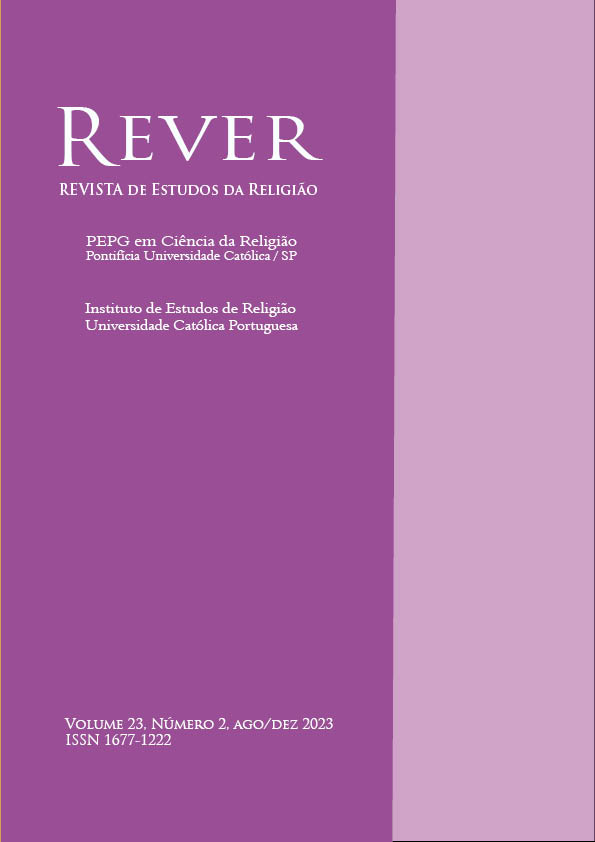Historical relationships between Buddhism and Hinduism in the Indian subcontinent
DOI:
https://doi.org/10.23925/1677-1222.2023vol23i2a13Keywords:
Buddhism, Hinduism, religious tensions, India, History of IndiaAbstract
Hinduism and Buddhism share a series of elements, such as its genesis in the Indian subcontinent, common principles, iconographical expressions and even certain deities. While Buddhism declined in India and became a universal religion strongly present in several countries, Hinduism continued to flourish in its land of origin. This article synthesizes the historical relations between Buddhism and Hinduism in the Indian subcontinent, seeking to understand how similarities and tensions, from the 5th century BCE to the present day, shaped and shape both religions.
References
ANAND, M., “Buddhists fight for control of Mahabodhi temple”, in Rediff.com, artigo em mídia digital publicado em 17.04.08 e disponível em https://www.rediff.com/news/2008/apr/17bodhi.htm (c. 01.11.23)
BAILEY, G., MABETT, I., “The Sociology of Early Buddhism”, Cambridge: Cambridge University Press, 2004, p.108-137.
BUSWELL, Robert, e LOPEZ, Donald, "The Princeton Dictionary of Buddhism", 1ª edição, Princeton: Princeton University Press, 2014, 1265 p.
CROSBY, K., “Persecutions” in BUSWELL, R. (Ed.), Encyclopedia of Buddhism, New York: Thompson/Gale 2004, p. 640-647.
DESHPANDE, M., “Language and Legitimacy: Buddhist and Hindu Techniques”, in SUBRAMANIAM, V. (Ed.), Buddhist-Hindu Interactions from Śakyamuni to Śankarācarya, Delhi: Ajanta Books, 1993, p. 22-46.
GÓMEZ, L., “Buddhism in India”, in Encyclopedia of Religion, Vol. II, Detroit: Thompson/Gale 2005, p.1101-1131.
HALBFASS, W., “Der Buddha und seine Lehre im Urteil des Hinduismus”, in: SCHMIDT-LEUKEL, P. (Ed.), Wer ist Buddha? Eine Gestalt und ihre Bedeutung für die Menschheit, München: Diederichs, 1998, p. 176-194.
HAYES, F. RICHARD P., “A Buddhist’s Reflections on Religious Conversion”, Elijah School Lectures For the Fourth Summer Program, August 2000, p. 19.
HAZRA, K., “The Rise and Decline of Buddhism in India”, Delhi: Munishiram Manoharlal, 1995, p. 46.
KANTOWSKY, D., Buddhists in India Today: Descriptions, Pictures and Documents, Delhi: Manohar 2003, p. 156.
KHAN, M., “'Why are Hindus controlling the Mahabodhi temple?'”, in Rediff.com, artigo em mídia digital publicado em 27.07.17 e disponível em https://www.rediff.com/news/interview/why-are-hindus-controlling-the-mahabodhi-temple/20170725.htm (c. 01.11.23)
KLOSTERMAIER, K., “Hindu Views of Buddhism” in AMORE, R. (Ed.), Developments in Buddhist Thought: Canadian Contribution to Buddhist Studies, Waterloo: Wilfried Laurie University Press, 1979, p. 60-82.
KLOSTERMAIER, K., “Hindu-Buddhist Interaction in Twentieth Century India” in SUBRAMANIAM, V. (Ed.), Buddhist-Hindu Interactions from Śakyamuni to Śankarācarya, Delhi: Ajanta Books 1993, p. 171-187.
LOPEZ, D., “Buddha”, in Idem (Ed.), Critical Terms for the Study of Buddhism, Chicago and London, University of Chicago Press, 2005, p.13-36, especialmente p. 24ss.
MATTANANDO BHIKKHU, “The Role of Buddhism in Inter-religious Dialogue”, in Buddhist Himalaya: A Journal of Nagarjuna Institute of Exact Methods, Vol. II, N. 1 & 2, 1989, disp. em http://ccbs.ntu.edu.tw/FULLTEXT/ JR-BH/bh117496.htm (c. 29.12.08).
MINISTÉRIO DA LEI E DA JUSTIÇA DA ÍNDIA, “Constituição da Índia”, em https://legislative.gov.in/constitution-of-india/ (c. 30.10.23).
OFFICE OF THE REGISTRAR GENERAL & CENSUS COMMISSIONER, portal oficial disponível em https://censusindia.gov.in/census.website/ (c. 01.11.23).
RAJAN, V., “Education, economics and protest drive changes and reform to India's ancient societal divisions”, in Hinduism Today, 30.06.2003.
REYNOLDS, F., HALLISEY, C., “Buddhism: An Overview”, in Encyclopedia of Religion, Vol. II, Detroit: Thompson/Gale 2005, p.1087-1101.
SANTIKARO: Ajahn Buddhadasa and Inter-Religious Understanding, ND, artigo disponível em http://www.suanmokkh.org/archive/pdf/TW_2.pdf (c. 07.01.2009).
SCHMIDT-LEUKEL, P., “Buddhist-Hindu Relations”, in. Idem. (Ed.), Buddhist Attitudes to Other Religions, St. Ottilien: EOS 2008, p. 143-171.
SCHNEIDER, U., “Einführung in den Buddhismus”, Darmstadt: Wissenschaftliche Buchgesellschaft, 1992, p. 65-66.
SENEVIRATNE, K., “India: Conflict in the Cradle of Buddhism”, Inter Press Service English News Wire, 10.07.1996.
SMARTSCRAPERS, “Number of Ashrams in India”, disponível em https://rentechdigital.com/smartscraper/business-report-details/india/ashrams (c. 28.10.23).
STARK, R., “Why Religious Movements Succeed or Fail: A Revised General Model, Journal of Contemporary Religion”,
Downloads
Published
How to Cite
Issue
Section
License

This work is licensed under a Creative Commons Attribution-NonCommercial 4.0 International License.
Authors who publish in this journal agree with the following terms:- Authors retain copyright, but grant the journal the right of first publication, with the work simultaneously licensed under the Creative Commons BY-NC License.
- Authors are authorized to assume additional contracts separately, for non-exclusive distribution of the work published in this journal (e.g., publishing in an institutional repository or as a book chapter), as long as with acknowledgment of authorship and first publication in this journal.


